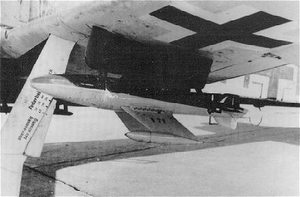Stargaard X56 (missile)
This article is incomplete because it is pending further input from participants, or it is a work-in-progress by one author. Please comment on this article's talk page to share your input, comments and questions. Note: To contribute to this article, you may need to seek help from the author(s) of this page. |
| X56 | |
|---|---|
 Stargaard X56 equipped on a Neßerschmitt Ne-509, 1942 | |
| Type | Air-to-air missile |
| Place of origin | |
| Service history | |
| In service | 1940-1951 (Englean Kaiserreich) |
| Used by | See operators |
| Wars | Second Great War |
| Production history | |
| Designer | Alexander Stargaard |
| Designed | 1935-1940 |
| Manufacturer | Königlug Technologies Corporation |
| Produced | 1940-1947 |
| Specifications | |
| Weight | 60 kg (132.3 lb) |
| Length | 201 cm (79.1 in) |
| Diameter | 22 cm (8.7 in) |
| Warhead | HE Blast-Fragmentation |
Detonation mechanism | Proximity fuse |
| Engine | Liquid fuel rocket |
| Wingspan | 726 cm (285.8 in) |
Operational range | 1.5–3.5 km |
| Speed | 325 m/s |
Guidance system | MCLOS visual guidance w/ wire |
Launch platform | Aircraft |
The Stargaard X56 was a wire guided air-to-air missile designed by the Englean Kaiserreich as a rudimentary air-to-air missile for usage on aircraft. The X56 was used extensively by the Luftstreitkräfte as a way to quickly eliminate aircraft deployed by Damsmarian invasion forces, and later during the Invasion of Damsmar. Eventually the X56 would be developed into an anti-tank guided missile for usage from aircraft and on the ground, being deployed alongside the X-84 Panzerschreck in 1943. The X56 continued to be in service with the Englean Kaiserreich until 1951, when advances in missile technologies made the Second Great War vintage weapon obsolete. The X56 was developed into the Meeraesche surface-to-air missile developed by and in service with the Kaiserliche-Marine from 1953-1986.
History
The X56 originated from earlier attempts by Dr. Alexander Stargaard to create reliable rocket engines using a mixture of nitric acid and iron (III) chloride, which gained the attention of General der Fliegertruppe Berthold Kirchweger in 1933. Being a veteran of the First Great War as a volunteer pilot in the Aznazian Air Force, General Kirchweger envisioned the ability to guide a rocket as a longer-ranged weapon against enemy aircraft. He believed that this form of weapon would greatly extend the element of surprise, where enemy aircraft would not be aware of incoming missiles before they detonated. General Kirchweger convinced the Luftstreitkräfte command of the idea, and Dr. Stargaard was placed in charge of the project in 1935.
Design
Operation
Further Development
==Operators